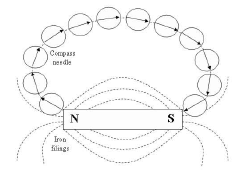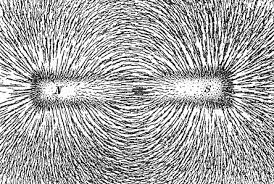Science > Physics > Magnetism > Magnetic Field and Magnetic Lines of Force
In this article, we shall study the concept of a magnetic field, magnetic lines of force, types of magnetic material.
When a magnetic needle is kept on a wooden table it comes to rest in the north-south direction. If another magnet is kept on a table the needle comes to rest in some other direction such that one of its poles is in the direction towards the nearer pole of the magnet. Thus the property of the space in which the magnetic needle is kept is changed.
The space around a magnet in which the needle of a compass rests in a direction other than geographical north-south direction is called a magnetic field. It is a vector quantity. It has a magnitude as well as direction. The direction of the field at a point is in the direction in which the needle of the compass rests when it is kept at that point.
Magnetic Lines of Force:
The magnetic field can be represented by drawing lines called as magnetic lines of force. A magnetic line of force is defined as a curve drawn in the magnetic field in such a way that the tangent to the curve at any points gives the direction of the field.
Plotting of Magnetic Lines of Force:

Draw a line in the middle of a paper fixed on a drawing board to represent the magnetic axis of the magnet. Place the magnet on the paper such that its magnetic axis coincides with the line drawn on the paper. Mark the outline of the magnet. Keep a small plotting magnetic needle (plotting compass) and place it on paper such that its south pole is directed towards point 0 at the edge of the bar magnet, and mark the point b1 in the direction in which the north pole of the compass points. Repeat the procedure by shifting the compass to a new point such that its south pole is directed towards point 1 to get point 2, 3, 4,…., Draw a smooth curve through all plotted points, which give the magnetic lines of force.
Experiment to Show Nature of Lines Formed Due to Bar Magnet:
Place a magnet below a sheet of stiff paper and spread iron filings on the top of the paper uniformly. Tap the paper gently. We observe that the iron filings arrange themselves along the curved lines as shown.

These lines are called magnetic lines of force and are formed due to induced magnetism in iron filings and aligning in the direction of the field created y the magnet. If the compass needle is placed at any point its needle rests along the magnetic line of force.
Pattern of Magnetic Lines of Force:
Bar Magnet:

Horse Shoe Magnet:

Two Bar Magnet Unlike Poles Facing Each Other:

Two Bar Magnet Like Poles Facing Each Other

Characteristics of Magnetic Lines of Force:
- Magnetic lines of force are imaginary (hypothetical).
- They are closed, continuous curves.
- Magnetic lines of force always emerge or start from the north pole and terminate on the south pole. Inside the magnet, the lines of force move from the south pole to the north pole.
- The lines of force emerged or terminate normally to the surface of the magnet.
- When two dissimilar poles of two magnets are brought near each other the lines of force assist each other hence there is an attraction between two poles.
- When two similar poles of two magnets are brought near each other the lines of force oppose each other and there is repulsion between the two poles.
- The lines of force never intersect each other if they do so it means that there are two directions for the magnetic field at the point of intersection, which is not possible
- Lines of force have a tendency to shirk.
- Lines of force exert lateral pressure on each other.
- The strength of the magnetic field depends on the number of lines per unit area. This quantity is called the intensity of the magnetic field. If the lines of force are crowded together then the magnetic field is strong. We can observe that the lines of force are crowded near the poles, where the magnetic strength of the field is more.
- If the lines of force are equally spaced then the field is uniform.
Types of Magnetic Fields:
- If a magnetic induction has the same magnitude and direction at all the points in the region, then the magnetic field is said to be uniform.
- If a magnetic induction varies in both the magnitude and the direction at all the points in the region, then the magnetic field is said to be nonuniform.
- Earth’s magnetic field may be regarded as a uniform over a small region.
Representation of Magnetic Field:
Uniform Magnetic Field:

Uniform Magnetic Field Perpendicular to Plane of Paper and Coming Out of It:

Uniform Magnetic Field Perpendicular to Plane of Paper and Going into It:

Origin of Magnetism:
The origin of magnetism in substances can be explained by considering the circular motion of electrons. The electrons in atoms move in circular orbits around the nucleus which is equivalent to a circular coil carrying current. The orbital motion of electrons gives rise to an orbital magnetic moment.
In addition, the electrons spin about its own axis constituting a spin magnetic moment. The resultant magnetic moment of an atom is the vector sum of the orbital and spin magnetic moment.
Types of Magnetic Substances:
Diamagnetic Substances:
Those substances which are weekly magnetized when placed in an external magnetic field, in a direction opposite to the applied field are called diamagnetic substances. They tend to move from stronger to weaker parts of the field. Examples: Copper, Gold, Antimony, Bismuth, Water, Air, Hydrogen, etc.
Paramagnetic Substances:
Those substances which are weekly magnetized when placed in an external magnetic field in the same direction as the applied field are called Paramagnetic substances. They tend to move from weaker to a stronger part of the field. Examples: Aluminium, Platinum, Manganese, Crown glass, oxygen, etc.
Ferromagnetic Substances:
Those substances which are strongly magnetized in an external magnetic field in the same direction as the external applied field and retain its magnetic moment even after the removal of the external field are Called Ferromagnetic substances. They have a very strong tendency to move from weaker to the stronger parts of the external field. Examples: Iron, cobalt, nickel
Curie Temperature:
It is the temperature required to destroy the alignment of domains and to make a ferromagnetic substance demagnetized. Above Curie temperature. a ferromagnetic substance behaves as paramagnetic. e.g. Fe (770 °C), Ni (360 °C), Co (1150 °C).
Previous Topic: Magnetization, Demagnetization, and Induced Magnetism